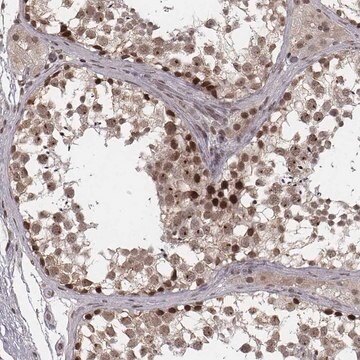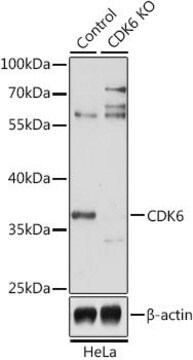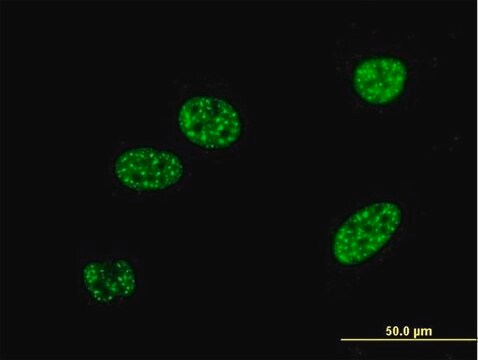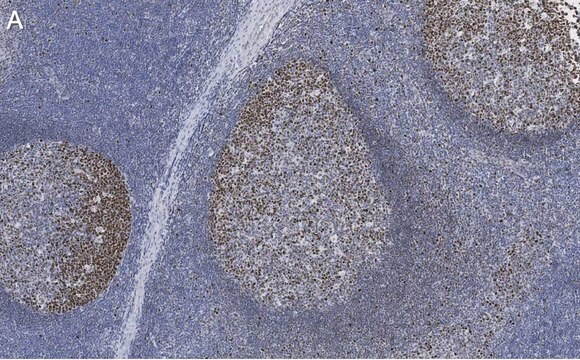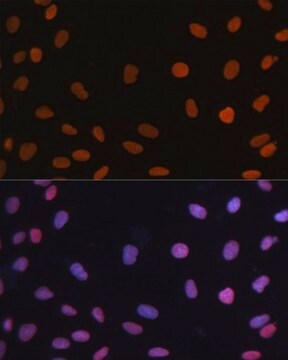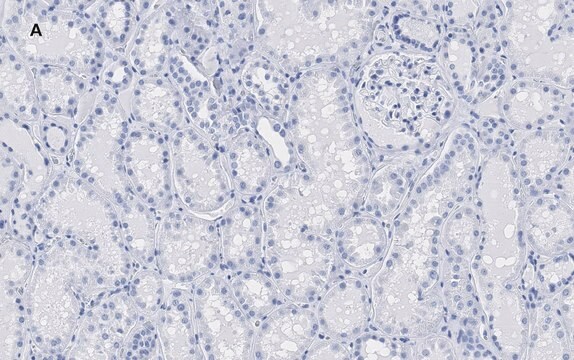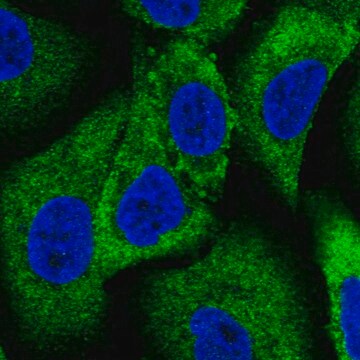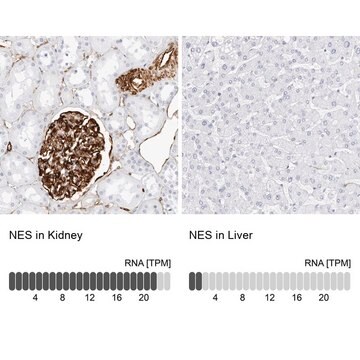推荐产品
生物源
mouse
品質等級
共軛
unconjugated
抗體表格
purified immunoglobulin
抗體產品種類
primary antibodies
無性繁殖
2D10, monoclonal
形狀
buffered aqueous solution
物種活性
human
技術
immunofluorescence: suitable
indirect ELISA: suitable
western blot: 1-5 μg/mL
同型
IgG1κ
GenBank登錄號
UniProt登錄號
運輸包裝
dry ice
儲存溫度
−20°C
目標翻譯後修改
unmodified
基因資訊
human ... HMGA2(8091)
一般說明
This gene encodes a protein that belongs to the non-histone chromosomal high mobility group (HMG) protein family. HMG proteins function as architectural factors and are essential components of the enhancesome. This protein contains structural DNA-binding domains and may act as a transcriptional regulating factor. Identification of the deletion, amplification, and rearrangement of this gene that are associated with myxoid liposarcoma suggests a role in adipogenesis and mesenchymal differentiation. A gene knock out study of the mouse counterpart demonstrated that this gene is involved in diet-induced obesity. Alternate transcriptional splice variants, encoding different isoforms, have been characterized. (provided by RefSeq)
免疫原
HMGA2 (NP_003474, 1 a.a. ~ 92 a.a) partial recombinant protein with GST tag. MW of the GST tag alone is 26 KDa.
Sequence
MSARGEGAGQPSTSAQGQPAAPAPQKRGRGRPRKQQQEPTGEPSPKRPRGRPKGSKNKSPSKAAQKKAEATGEKRPRGRPRKWPQQVVQKKP
Sequence
MSARGEGAGQPSTSAQGQPAAPAPQKRGRGRPRKQQQEPTGEPSPKRPRGRPKGSKNKSPSKAAQKKAEATGEKRPRGRPRKWPQQVVQKKP
外觀
Solution in phosphate buffered saline, pH 7.4
法律資訊
GenBank is a registered trademark of United States Department of Health and Human Services
免責聲明
Unless otherwise stated in our catalog or other company documentation accompanying the product(s), our products are intended for research use only and are not to be used for any other purpose, which includes but is not limited to, unauthorized commercial uses, in vitro diagnostic uses, ex vivo or in vivo therapeutic uses or any type of consumption or application to humans or animals.
未找到合适的产品?
试试我们的产品选型工具.
儲存類別代碼
10 - Combustible liquids
閃點(°F)
Not applicable
閃點(°C)
Not applicable
個人防護裝備
Eyeshields, Gloves, multi-purpose combination respirator cartridge (US)
历史批次信息供参考:
分析证书(COA)
Lot/Batch Number
Bin Liu et al.
Human pathology, 45(8), 1752-1758 (2014-06-18)
High-mobility group AT-hook protein 2 (HMGA2) is an architectural transcription factor associated with malignancy, invasiveness, and poor prognosis in a variety of human neoplasms. This study investigated HMGA2 expression and prognostic value in human gliomas. We also correlated HMGA2 expression
Chung-Ta Lee et al.
Human pathology, 45(11), 2334-2340 (2014-09-24)
High-mobility group AT-hook 2 (HMGA2) regulates cell growth, differentiation, apoptosis, and neoplastic transformation. Previous studies have shown that malignant tumors expressing HMGA2, such as gastric, lung, and colorectal carcinomas, usually have a poor prognosis. HMGA2 expression and its clinical significance
Yuheng Tian et al.
Cell cycle (Georgetown, Tex.), 17(10), 1188-1198 (2018-06-09)
Long non-coding RNAs (lncRNAs) can actively participate in tumorigenesis in various cancers. However, the involvement of lncRNA long stress induced non-coding transcripts 5 (LSINCT5) in non-small cell lung cancer (NSCLC) remains largely unknown. Here we showed a novel lncRNA signature
Dequan Kong et al.
Medical oncology (Northwood, London, England), 31(8), 130-130 (2014-07-20)
High mobility group protein A2 (HMGA2) and octamer-binding transcription factor 4 (Oct4) are transcription factors that play major roles in the acquisition of cancer stemness phenotypes and tumorigenicity of malignant neoplasms. The aim of this study was to analyze the
Rika Fujii et al.
The Journal of steroid biochemistry and molecular biology, 144 Pt B, 513-522 (2014-09-03)
Aromatase inhibitors (AI) are commonly used to treat postmenopausal estrogen-receptor (ER)-positive breast carcinoma. However, resistance to AI is sometimes acquired, and the molecular mechanisms underlying such resistance are largely unclear. Recent studies suggest that AI treatment increases androgen activity during
我们的科学家团队拥有各种研究领域经验,包括生命科学、材料科学、化学合成、色谱、分析及许多其他领域.
联系客户支持